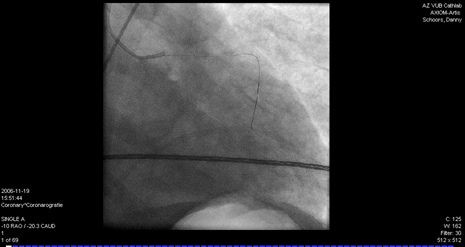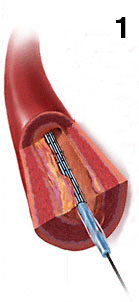Balloon dilatation and stenting
When a coronary artery is found to be significantly narrowed, it can often be expanded using a balloon (dilatation). The cardiologists will then leave a small tube (a stent) in place to keep it dilated.
Before your treatment
- The treatment and the possible associated risks will be discussed with you and your family beforehand.
- You must not eat or drink anything before you are admitted to hospital.
- On the day of the treatment a blood test will be carried out and a drip will be placed in your arm.
The treatment: balloon dilatation
- During the procedure you will be fully conscious, lying on the operating table in the cath lab. The intervention is carried out via the artery in your groin or wrist, and a small injection of local anaesthetic is given in that place. Your heart rhythm and blood pressure will be monitored closely.
- A sheath (a short tube) will be inserted in the artery in your groin or wrist and through this a guide catheter (long flexible tube) will be inserted as far as the aorta. The catheter then continues via the aorta into the coronary artery. A guide wire is passed through the guide catheter as far as the coronary artery, just beyond the place where the artery is narrowed (this place is called a stenosis).
- The X-ray machine takes pictures of the coronary arteries from various angles, which are displayed on the monitors. The guide catheter and the guide wire can both be clearly seen on the monitor.
- By injecting a contrast fluid, it is possible to indicate the exact site where the artery is narrowed. When the guide wire is in the correct position, the doctor slides the balloon catheter along to the place where the artery is narrowed and inflates it using a special pump. When an ordinary balloon is used, the plaque is squashed against the blood vessel wall so that the blood vessel is large enough to deliver oxygen-rich blood to the heart again.
- The balloon is deflated again and it is withdrawn along the guide wire.
- Depending on the time of day when the test is carried out, you may be able to go home the same day or the next day.
Before (image 1) and after (image 2) dilatation


Treatment: stenting
In many cases the doctor will also decide to insert a stent straight away. The principle is the same, except in this case there is a stent over the balloon, which is pressed into the blood vessel wall when the balloon is inflated. The stent ensures that the blood vessel cannot shrink down again over time.
|
|
1. A balloon catheter at the location of a stenosis. 2. The balloon is inflated and presses the stent against the vessel wall. 3. The stent remains in place when the catheter is removed. |
After the treatment
- After the test the tube is removed from the artery and a pressure dressing is applied by the nurse to prevent bleeding.
- Afterwards you will have to spend a few hours lying down in bed.
